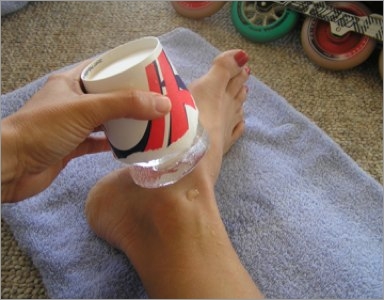 | ||
| ||||||||
By Nadine Currie Jackson
A cup of frozen water makes ice massage easy. Tell an injured skater to try icing, and you're liable to get the cold shoulder. "I don't like to ice," they often say. "It's cold and uncomfortable." True enough. But it's also one of the best ways to treat many common sports injuries. Cold therapy (also known as cryotherapy) reduces inflammation and pain and can speed up the healing process. On top of that, it's easy and cheap. When To Ice Icing is effective in the treatment of both acute and chronic soft-tissue injuries, including bruises, sprains and pulled (or just sore) muscles. In fact, it's good for just about any injury that involves inflammation. Signs of inflammation include redness, pain and warmth. But these are also symptoms of infection. So if you have these symptoms and haven't experienced some kind of trauma, consult a doctor immediately. How to ice There are lots of ways to ice. You can apply ice packs, frozen towels, gel packs or bags of frozen peas. Or you can take ice baths or jump in a cold-water spring. (Brrr!) But my favorite method is to give myself a localized ice massage, which is quicker than an ice pack and less jolting than an ice bath. An easy and effective way to give yourself an ice massage
How long to apply ice Some experts recommend icing for 10 minutes; others say more is better. I go by how it feels. When treating clients, I ask for feedback. Use the C-B-A-N rule as your guide: C-B-A-N
Immediately remove the ice once you feel numbness. This is very important because the next stage is F: frostbite! Not a good thing because it can damage lymphatic vessels and destroy nerve and other soft tissues. Ice reps I usually apply ice at 45-minute intervals. Once the injured area is numb, I remove the ice and reapply 45 minutes later. I do this for the first few hours after an injury. This allows me to reduce inflammation without popping pills. Sensible precautions! If you are suffering from a medical condition or taking medication, please consult your doctor before icing.
Here's what the book Cryotherapy Theory: Technique and Physiology has to say on the subject: "Avoid cryotherapy if you have any of the following conditions: areas of loss of sensation, circulatory disorders, open wounds, tissue metabolic disorders, frostbite, if your medication causes thermoregulation problems, hypersensitivity to cold, cardiac disease and regeneration to peripheral nerves." Got that? Good. Now go to the fridge and get your ice cups ready! Oct. 23, 2009 ---
Related reading: • Skate Tip of the Week Archive
...
Copyright © 2009 Inline Planet | ||||||||



